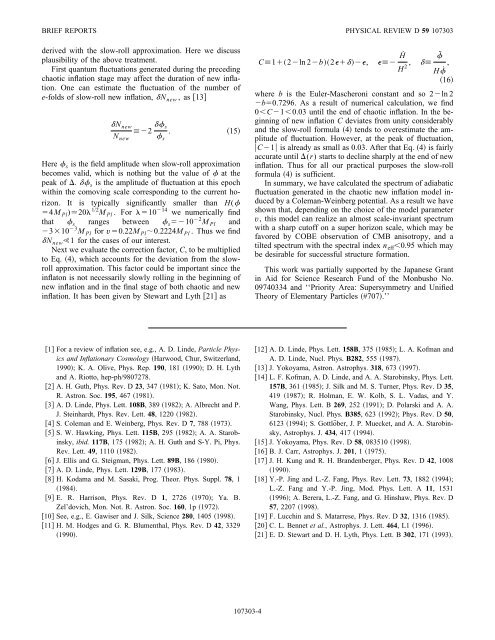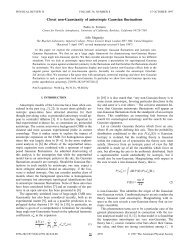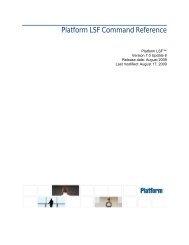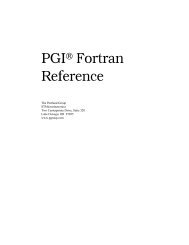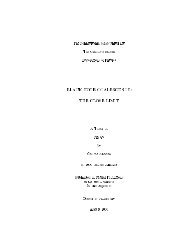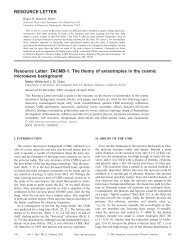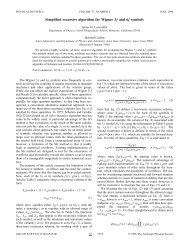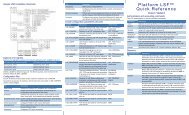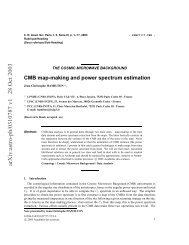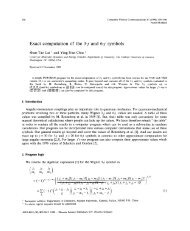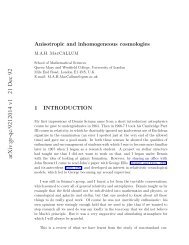Chaotic new inflation and primordial spectrum of adiabatic ... - iucaa
Chaotic new inflation and primordial spectrum of adiabatic ... - iucaa
Chaotic new inflation and primordial spectrum of adiabatic ... - iucaa
Create successful ePaper yourself
Turn your PDF publications into a flip-book with our unique Google optimized e-Paper software.
BRIEF REPORTS PHYSICAL REVIEW D 59 107303derived with the slow-roll approximation. Here we discussplausibility <strong>of</strong> the above treatment.First quantum fluctuations generated during the precedingchaotic <strong>inflation</strong> stage may affect the duration <strong>of</strong> <strong>new</strong> <strong>inflation</strong>.One can estimate the fluctuation <strong>of</strong> the number <strong>of</strong>e-folds <strong>of</strong> slow-roll <strong>new</strong> <strong>inflation</strong>, N <strong>new</strong> ,as13N <strong>new</strong>N <strong>new</strong>2 s s.15Here s is the field amplitude when slow-roll approximationbecomes valid, which is nothing but the value <strong>of</strong> at thepeak <strong>of</strong> . s is the amplitude <strong>of</strong> fluctuation at this epochwithin the comoving scale corresponding to the current horizon.It is typically significantly smaller than H(4M Pl )20 1/2 M Pl . For 10 14 we numerically findthat s ranges between s 10 2 M Pl <strong>and</strong>310 3 M Pl for v0.22M Pl 0.2224M Pl . Thus we findN <strong>new</strong> 1 for the cases <strong>of</strong> our interest.Next we evaluate the correction factor, C, to be multipliedto Eq. 4, which accounts for the deviation from the slowrollapproximation. This factor could be important since theinflaton is not necessarily slowly rolling in the beginning <strong>of</strong><strong>new</strong> <strong>inflation</strong> <strong>and</strong> in the final stage <strong>of</strong> both chaotic <strong>and</strong> <strong>new</strong><strong>inflation</strong>. It has been given by Stewart <strong>and</strong> Lyth 21 asC12ln 2b2, Ḣ ¨, 2H H˙ ,16where b is the Euler-Mascheroni constant <strong>and</strong> so 2ln 2b0.7296. As a result <strong>of</strong> numerical calculation, we find0C10.03 until the end <strong>of</strong> chaotic <strong>inflation</strong>. In the beginning<strong>of</strong> <strong>new</strong> <strong>inflation</strong> C deviates from unity considerably<strong>and</strong> the slow-roll formula 4 tends to overestimate the amplitude<strong>of</strong> fluctuation. However, at the peak <strong>of</strong> fluctuation,C1 is already as small as 0.03. After that Eq. 4 is fairlyaccurate until (r) starts to decline sharply at the end <strong>of</strong> <strong>new</strong><strong>inflation</strong>. Thus for all our practical purposes the slow-rollformula 4 is sufficient.In summary, we have calculated the <strong>spectrum</strong> <strong>of</strong> <strong>adiabatic</strong>fluctuation generated in the chaotic <strong>new</strong> <strong>inflation</strong> model inducedby a Coleman-Weinberg potential. As a result we haveshown that, depending on the choice <strong>of</strong> the model parameterv, this model can realize an almost scale-invariant <strong>spectrum</strong>with a sharp cut<strong>of</strong>f on a super horizon scale, which may befavored by COBE observation <strong>of</strong> CMB anisotropy, <strong>and</strong> atilted <strong>spectrum</strong> with the spectral index n eff 0.95 which maybe desirable for successful structure formation.This work was partially supported by the Japanese Grantin Aid for Science Research Fund <strong>of</strong> the Monbusho No.09740334 <strong>and</strong> ‘‘Priority Area: Supersymmetry <strong>and</strong> UnifiedTheory <strong>of</strong> Elementary Particles #707.’’1 For a review <strong>of</strong> <strong>inflation</strong> see, e.g., A. D. Linde, Particle Physics<strong>and</strong> Inflationary Cosmology Harwood, Chur, Switzerl<strong>and</strong>,1990; K. A. Olive, Phys. Rep. 190, 181 1990; D. H. Lyth<strong>and</strong> A. Riotto, hep-ph/9807278.2 A. H. Guth, Phys. Rev. D 23, 347 1981; K. Sato, Mon. Not.R. Astron. Soc. 195, 467 1981.3 A. D. Linde, Phys. Lett. 108B, 389 1982; A. Albrecht <strong>and</strong> P.J. Steinhardt, Phys. Rev. Lett. 48, 1220 1982.4 S. Coleman <strong>and</strong> E. Weinberg, Phys. Rev. D 7, 788 1973.5 S. W. Hawking, Phys. Lett. 115B, 295 1982; A. A. Starobinsky,ibid. 117B, 175 1982; A. H. Guth <strong>and</strong> S-Y. Pi, Phys.Rev. Lett. 49, 1110 1982.6 J. Ellis <strong>and</strong> G. Steigman, Phys. Lett. 89B, 186 1980.7 A. D. Linde, Phys. Lett. 129B, 177 1983.8 H. Kodama <strong>and</strong> M. Sasaki, Prog. Theor. Phys. Suppl. 78, 11984.9 E. R. Harrison, Phys. Rev. D 1, 2726 1970; Ya. B.Zel’dovich, Mon. Not. R. Astron. Soc. 160, 1p1972.10 See, e.g., E. Gawiser <strong>and</strong> J. Silk, Science 280, 1405 1998.11 H. M. Hodges <strong>and</strong> G. R. Blumenthal, Phys. Rev. D 42, 33291990.12 A. D. Linde, Phys. Lett. 158B, 375 1985; L. A. K<strong>of</strong>man <strong>and</strong>A. D. Linde, Nucl. Phys. B282, 555 1987.13 J. Yokoyama, Astron. Astrophys. 318, 673 1997.14 L. F. K<strong>of</strong>man, A. D. Linde, <strong>and</strong> A. A. Starobinsky, Phys. Lett.157B, 361 1985; J. Silk <strong>and</strong> M. S. Turner, Phys. Rev. D 35,419 1987; R. Holman, E. W. Kolb, S. L. Vadas, <strong>and</strong> Y.Wang, Phys. Lett. B 269, 252 1991; D. Polarski <strong>and</strong> A. A.Starobinsky, Nucl. Phys. B385, 623 1992; Phys. Rev. D 50,6123 1994; S. Gottlöber, J. P. Muecket, <strong>and</strong> A. A. Starobinsky,Astrophys. J. 434, 417 1994.15 J. Yokoyama, Phys. Rev. D 58, 083510 1998.16 B. J. Carr, Astrophys. J. 201, 11975.17 J. H. Kung <strong>and</strong> R. H. Br<strong>and</strong>enberger, Phys. Rev. D 42, 10081990.18 Y.-P. Jing <strong>and</strong> L.-Z. Fang, Phys. Rev. Lett. 73, 1882 1994;L.-Z. Fang <strong>and</strong> Y.-P. Jing, Mod. Phys. Lett. A 11, 15311996; A. Berera, L.-Z. Fang, <strong>and</strong> G. Hinshaw, Phys. Rev. D57, 2207 1998.19 F. Lucchin <strong>and</strong> S. Matarrese, Phys. Rev. D 32, 1316 1985.20 C. L. Bennet et al., Astrophys. J. Lett. 464, L11996.21 E. D. Stewart <strong>and</strong> D. H. Lyth, Phys. Lett. B 302, 171 1993.107303-4


